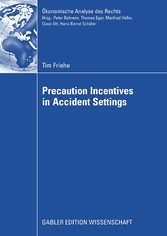Suchen und Finden
Chapter 5 Screening Accident Victims (S. 83-84)
1 Introduction
1.1 Motivation and Main Results
Administrative costs of the tort system are a considerable burden on society. Shavell (2004: 281) concludes for the United States that, on average, every dollar received by a victim creates a dollar or more in administrative costs. The literature on administrative costs has hitherto been concerned with, e.g., the divergence of the private and social motive to bring suit or the relative desirability of cost-shifting rules (see Spier forthcoming).
We turn to administrative costs that arise due to the assessment of damages and their e.ciency justi.cation. For instance, Shavell (2004: 237) asserts that compensation of the actual level of harm is the starting principle in most legal systems. Consequently, courts and/or litigants usually put forth considerable resources to establish the magnitude of actual damages.1 This paper is concerned with heterogeneous harm levels, bilateral care, and administrative costs associated with the veri.cation of harm levels in court.2 It is often the case that victims have a pretty good picture of the harm su.ered after an accident has occurred, whereas courts and injurers are notably less well informed. It might then be expected that victims use this information asymmetry to their advantage by misrepresenting the harm magnitude.
For instance, Kaplow and Shavell (1996) state that the primary objective of the plainti. is usually to collect as much as possible in litigation. Hence, resources spent on the accurate veri.cation appear justi.ed to correct for this tendency. The framework we consider distinguishes victim types by their harm magnitude and assumes that the court cannot tell the victim type without spending on administrative costs. The importance of uncertainty over harm is, for instance, evidenced by the ability of judges to bifurcate trials into one on liability and one on damages (see, e.g., Cooter and Ulen 2004: 428).
Our informational structure brings to the fore the role played by administrative costs in determining the harm magnitude. Take the instance of damages for loss of earnings, which is an essential element of tort liability. In establishing the present value of lost future income, a court will typically undertake the following steps: "
(1) wages are forecasted based upon an assumed growth rate, (2) if the injured victim is still employable, wages from an alternative occupation should be subtracted, but if the victim is deceased, amounts attributable to foregone personal consumption should be subtracted, (3) income taxes are subtracted, (4) each year’s remaining amount is then multiplied by the probability that the victim would still have been working if the accident had not occurred, (5) and .nally, the residual is discounted to present value at a risk-free rate of interest" (Krauss and Levy 1996: 328).
It is obvious that small changes in the assumptions on respective aspects have a tremendous impact on the resulting damages aggregate and may be highly disputed. Furthermore, note that several of these aspects are highly type-speci.c. For instance, future wages are dependent on the skills the plainti. possesses as well as his ability to create new capabilities. Likewise, the probability that the plainti. would still be working is some function of - inter alia - the past employment experience.
Alle Preise verstehen sich inklusive der gesetzlichen MwSt.







